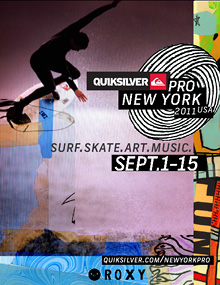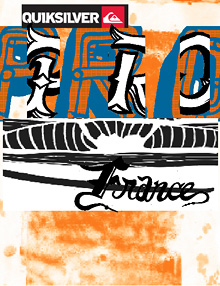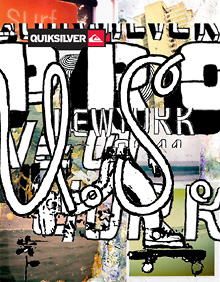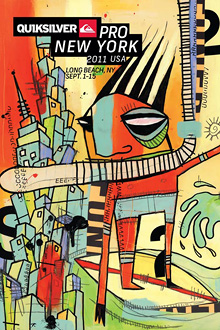David Carson (born September 8, 1954) is an American graphic designer. He is best known for his innovative magazine design, and use of experimental typography. He was the art director for the magazine Ray Gun. Carson was perhaps the most influential graphic designer of the 1990s. In particular, his widely imitated aesthetic defined the so-called "grunge typography" era.
Biography
Carson was born on September 8, 1954 in
Corpus Christi, Texas. Since then he has lived in and traveled extensively throughout the U.S. and Europe and lectured frequently around the world. Carson's first actual contact with graphic design was made in 1980 at the
University of Arizona on a two week graphics course, taught by Jackson Boelts. He attended
San Diego State University as well as Oregon College of Commercial Art. Later on in 1983, Carson was teaching high school Sociology in del mar California when he went to Switzerland, where he attended a three-week workshop in graphic design as part of his degree. This is where he met his first great influence, who also happened to be the teacher of this course,
Hans-Rudolf Lutz. Carson has a
Bachelor of Arts in
Sociology.
He became renowned for his inventive graphics in the 1990s. Having worked as a sociology teacher and professional surfer in the late 1970s, he art directed various music, skateboarding, and surfing magazines through the 1980/90s, including twSkateboarding, twSnowboarding, Surfer, Beach Culture and the music magazine Ray Gun. As art director of Ray Gun (1992-5), Carson came to worldwide attention. In a feature story, NEWSWEEK magazine said he "changed the public face of graphic design".
His layouts featured distortions or mixes of 'vernacular' typefaces and fractured imagery, rendering them almost illegible. Indeed, his maxim of the 'end of print' questioned the role of type in the emergent age of digital design, following on from California New Wave and coinciding with experiments at the Cranbrook Academy of Art. In the later 1990s he added corporate clients to his list of clients. including Microsoft, Armani, Nike, Levis, British Airways, Quiksilver, Sony, Pepsi, Citibank, Yale University, Toyota and many others. When Graphic Design USA Magazine (NYC) listed the “most influential graphic designers of the era” David was listed as one of the all time 5 most influential designers, with Milton Glaser, Paul Rand, Saul Bass and Massimo Vignelli.
Career
From 1982 to 1987, Carson worked as a teacher in
Torrey Pines High School in
San Diego, California. In 1983, Carson started to experiment with graphic design and found himself immersed in the artistic and bohemian culture of Southern California. By the late 1980s he had developed his signature style, using "dirty" type and non-mainstream photographic techniques.
Carson went on to become the art director of
Transworld Skateboarding magazine. Among other things, he was also a professional surfer, and in 1989 Carson was qualified as the 9th best surfer in the world.
[2] Steve and Debbee Pezman, publishers of Surfer magazine (and later Surfers Journal) tapped Carson to design Beach Culture, which evolved out of a to-the-trade annual supplement; the new, quarterly publication was called Beach Culture. Though only six quarterly issues were produced, the tabloid-size venue—edited by author Neil Fineman—allowed Carson to make his first significant impact on the world of graphic design and typography—with ideas that were called innovative even by those that were not fond of his work, in which legibility often relied on readers' strict attention (for one feature on a blind surfer, Carson opened with a two-page spread covered in black). A stint at How magazine (a trade magazine aimed at designers) followed, and soon Carson was hired by publisher Marvin Scott Jarrett to design Ray Gun, a magazine of international standards which had music and lifestyle as its subject. Not afraid to break convention, in one issue he used
Dingbat as the font for what he considered a rather dull interview with
Bryan Ferry.
[3] (However, the whole text was published in a legible font at the back of the same issue of RayGun, complete with a repeat of the asterisk motif). Ray Gun made Carson very well known and attracted new admirers to his work. In this period, publications such as the
New York Times (May 1994) and
Newsweek (1996) featured Carson and increased his publicity greatly. In 1995, Carson founded his own studio, David Carson Design, in New York City, and started to attract major clients from all over the United States. During the next three years (1995–1998), Carson was doing work for
Pepsi Cola,
Ray Ban (orbs project),
Nike,
Microsoft,
Budweiser,
Giorgio Armani,
NBC,
American Airlines and
Levi Strauss Jeans, and later worked for a variety of new clients, including
AT&T,
British Airways,
Kodak,
Lycra,
Packard Bell,
Sony,
Suzuki,
Toyota,
Warner Bros.,
CNN, Cuervo Gold,
Johnson AIDS Foundation,
MTV Global,
Princo,
Lotus Software,
Fox TV,
Nissan,
quiksilver,
Intel,
Mercedes-Benz,
MGM Studios and
Nine Inch Nails. He, along with Tina Meyers, designed the "crowfiti" typeface used in the film
The Crow: City of Angels. He named and designed the first issue of the adventure lifestyle magazine Blue, in 1997. David designed the first issue and the first three covers, after which his assistant Christa Smith art directed and designed the magazine until its demise. Carson's cover design for the first issue was selected as one of the "top 40 magazine covers of all time" by the American Society of Magazine Editors.
[4]
In 2000, Carson closed his New York City studio and followed his children, Luke and Luci, to Charleston, South Carolina where their mother had relocated them. In 2004, Carson became the Creative Director of
Gibbes Museum of Art in Charleston, designed the special “Exploration” edition of Surfing Magazine, and directed a television commercial for
UMPQUA Bank in Seattle, Washington.
Carson claims that his work is "subjective, personal and very self indulgent".
Carson's work is familiar among the generation that grew up with Ray Gun Magazine, and in general, the visually savvy
MTV generation. He took photography and type and manipulated and twisted them together and on some level confusing the message but in reality he was drawing the eyes of the viewer deeper within the composition itself. Steven Heller, of the
New York Times book review and numerous books on design, said “He significantly influenced a generation to embrace typography as an expressive medium” while design educator and historian Ellen Lupton said after the release of Davids 4th book Trek. "David Carson continues to be one of the worlds most distinctive typographic voices--much imitated, but never matched" (ID Mag.nyc).
AIGA (the American Institute of Graphic Arts) called Carson "our biggest star". The magazine
Eye (london) produced a graphic chart showing Carson to be the most 'googled' graphic designer ever.
Carson continues to lecture extensively throughout the world, including in 2010/11".
in 2010 Carson worked as worldwide Creative Director for Bose Corporation. He also served as Design Director for the 2011 Quiksilver Pro Surfing contest in Biarritz, France, and designed the branding for the 2011 Quiksilver Pro in New York City. He also designed a set of three posters for the
San Sebastián International Film Festival in Spain and the covers for Huck and Little White Lies magazines. He was featured in 2011 in interviews in Vice magazine and Monster Children, as well as large features in Spain and Portugals largest newspapers. Carson designed the cover of the summer 2011 "Time based Art" issue and catalogue of Mercury mag in Portland, Oregon. Carson has been invited to judge the Europena Design Awards in London (DD+A) in both 2010 and 2011. Since 2010, he has lectured, held workshops and exhibitions in France, Portugal, Madrid, San Sabastion, Los Angeles, Novi Sad, Serbia, Ukraine, Sweden, London, Argentina, Brazil, India, Chile, Germany, Italy, Australia, and various states in the U.S.
Awards
During the period of 1989–2004, David Carson has won over 170 Awards for his work in graphic design. Some of these awards include:
- Best Overall Design, Society of Publication Designers in New York.
- Cover of the Year, Society of Publication Designers in New York.
- Award of Best Use of Photography in Graphic Design
- Designer of the Year 1998, International Center of Photography
- Designer of the Year 1999, International Center of Photography
- Master of Typography, Graphics magazine (NY)
- The most famous graphic designer on the planet, April 2004 - London Creative Review magazine (London)
http://en.wikipedia.org/wiki/David_Carson_(graphic_designer)



